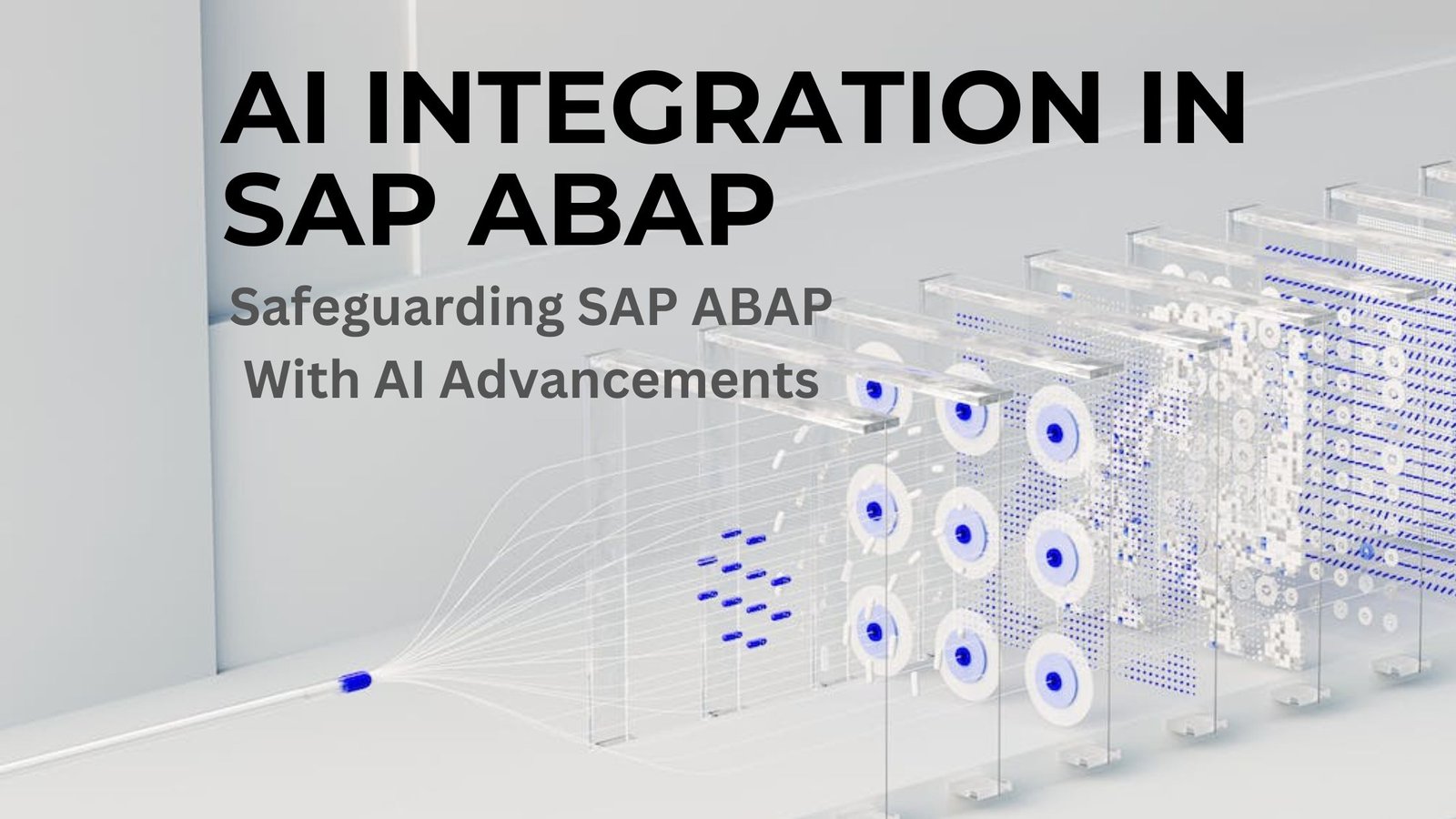I. Introduction
In the ever-evolving landscape of technology, whispers of transformation and innovation are the lifeblood of progress. Today, one such intriguing conversation resonates through the corridors of the tech world: the potential replacement of SAP ABAP by Artificial Intelligence (AI).
As organizations continually seek ways to enhance efficiency and stay on the cutting edge, the marriage of AI and traditional enterprise programming languages becomes a focal point of discussion.
The mere suggestion of AI stepping into the realm of SAP ABAP sparks curiosity and raises questions about the future of programming as we know it. Are we on the brink of a revolutionary shift, and how will it reshape the way we conceive and implement enterprise solutions?
Beyond the speculation lies a deeper exploration into the significance and profound impact of AI on the evolution of programming languages. This discussion extends far beyond the confines of SAP ABAP, reaching into the very core of how we conceive, develop, and interact with the intricate languages that power our digital world.
The exploration of this union is not just a matter of technical curiosity; it’s a journey into the future of technology, where the synergy of human ingenuity and artificial intelligence promises to redefine the boundaries of what’s possible.
II. Understanding SAP ABAP
SAP ABAP Overview:
SAP Advanced Business Application Programming (ABAP) stands as the bedrock of enterprise software development within the SAP ecosystem. This high-level programming language was specifically crafted to facilitate the creation of robust and scalable business applications. SAP ABAP plays a pivotal role in streamlining the intricate processes of enterprise resource planning (ERP), ensuring seamless communication and integration across various modules.
Key Features and Strengths of SAP ABAP:
Data Dictionary:
At the heart of SAP ABAP is its comprehensive Data Dictionary, allowing developers to define and manage data elements, structures, and database objects with precision. This feature ensures data integrity and consistency throughout the system.
Modularity:
SAP ABAP embraces a modular approach, enabling the creation of reusable and easily maintainable code. This modularity contributes to the scalability of applications and facilitates the efficient management of complex business processes.
Integration Capabilities:
One of the defining strengths of SAP ABAP lies in its seamless integration with other SAP modules and external systems. This interoperability ensures a cohesive flow of information across an organization’s entire technological landscape.
SAP GUI (Graphical User Interface):
The graphical user interface provided by SAP ABAP simplifies the development process, offering a user-friendly environment for programmers to design and implement business applications efficiently.
Database Independence:
SAP ABAP exhibits a remarkable level of database independence. This means that applications developed in ABAP can seamlessly interact with various databases, providing flexibility and adaptability to different organizational requirements.
Security Features:
Security is paramount in enterprise software, and SAP ABAP incorporates robust security measures. From user authentication to authorization checks, ABAP ensures that sensitive business data remains protected from unauthorized access.
III. The Rise of AI in Enterprise Systems
In the relentless march of technological progress, the integration of Artificial Intelligence (AI) has emerged as a transformative force within the realm of business and technology. The dynamic landscape of enterprise systems is undergoing a paradigm shift, with AI becoming a linchpin in the pursuit of heightened efficiency and innovation.
Overview of the Current Landscape:
As businesses worldwide seek competitive advantages, AI has become a cornerstone in optimizing processes, automating tasks, and unlocking unprecedented insights. The current AI landscape is characterized by a diverse array of applications, ranging from machine learning algorithms that predict consumer behavior to natural language processing systems that facilitate human-computer interaction.
AI’s impact extends beyond individual applications, permeating entire enterprise systems. It has become an integral component of decision-making processes, augmenting human capabilities and contributing to the evolution of how organizations operate.
Examples of Successful AI Integration in ERP Systems:
Predictive Analytics in Supply Chain Management:
Companies leverage AI-powered predictive analytics in ERP systems to forecast demand, optimize inventory levels, and enhance supply chain efficiency. This results in cost savings and improved customer satisfaction.
Chatbots and Customer Service:
AI-driven chatbots seamlessly integrated into ERP systems enhance customer service by providing instant responses to inquiries, handling routine tasks, and ensuring 24/7 availability.
Financial Forecasting and Planning:
ERP systems enhanced with AI algorithms enable more accurate financial forecasting and planning. By analyzing historical data and market trends, AI contributes to informed decision-making in financial management.
Automation of Repetitive Tasks:
AI-powered robotic process automation (RPA) embedded in ERP systems automates mundane and repetitive tasks, allowing employees to focus on more strategic and value-added activities.
Enhanced Data Security with AI:
AI is instrumental in fortifying ERP systems against cyber threats. Advanced AI algorithms can detect and respond to security breaches in real time, bolstering the overall cybersecurity posture of enterprise systems.
The successful integration of AI into ERP systems is not merely a technological feat but a strategic imperative. Businesses that embrace this evolution gain a competitive edge by fostering agility, innovation, and resilience in the face of an ever-changing business landscape.
As we delve into the potential replacement of SAP ABAP by AI, understanding these successful integration stories becomes crucial in envisioning the future of enterprise programming.
IV. Pros and Cons of AI in SAP ABAP
Advantages
Improved Efficiency and Automation:
Incorporating AI into SAP ABAP introduces a new era of efficiency. Automation of routine tasks streamlines processes, allowing developers to focus on more complex and strategic aspects of programming. This efficiency not only accelerates development cycles but also enhances the overall performance of enterprise systems.
Enhanced Decision-Making Capabilities:
AI augments the decision-making capabilities of SAP ABAP by providing data-driven insights. Machine learning algorithms can analyze vast datasets, identify patterns, and offer actionable recommendations. This enables developers and businesses to make informed decisions, leading to more effective and strategic outcomes.
Challenges
Potential Job Displacement:
As AI takes on more routine and repetitive tasks in programming, there is a concern about potential job displacement for traditional SAP ABAP developers. While AI enhances efficiency, it may necessitate a shift in skill sets, prompting a need for upskilling or reskilling within the workforce.
Security and Ethical Concerns:
The integration of AI in SAP ABAP introduces new dimensions of security and ethical considerations. AI systems, if not carefully designed and monitored, could pose risks such as data breaches or biased decision-making.
Ensuring the ethical use of AI and safeguarding against security vulnerabilities become critical challenges in this evolving landscape.
While the advantages of incorporating AI into SAP ABAP are promising, acknowledging and addressing the associated challenges is imperative. Striking a balance between efficiency gains and ethical considerations will be crucial in navigating the transition toward a future where AI plays an integral role in enterprise programming.
V. The Future Landscape
The future of programming languages stands at the intersection of tradition and innovation, with the evolving landscape poised to be shaped by the integration of Artificial Intelligence (AI). As we venture into uncharted territories, the possibilities of AI-driven programming promise to redefine not only how we code but also the very essence of programming languages.
Exploration of the Evolving Programming Languages:
The traditional paradigms of programming languages are undergoing a metamorphosis. New languages, designed with AI in mind, are emerging to harness the power of machine learning, natural language processing, and neural networks. These languages are not merely tools for developers; they are conduits for translating human creativity into intelligent, self-learning systems.
Possibilities of AI-Driven Programming:
AI-driven programming opens doors to unprecedented possibilities. Imagine a programming language that learns from its own iterations, adapts to user preferences, and anticipates coding needs. This symbiotic relationship between human programmers and AI algorithms has the potential to revolutionize how software is conceptualized, developed, and maintained.
The future landscape of programming may very well be characterized by dynamic languages that evolve in real-time, responding to the ever-changing demands of technology.
VI. Use Cases
1. Advanced Analytics & Forecasting
Many operational activities, including supply chain management and production, stand to gain from precise predictions. AI models can enhance forecasting by leveraging historical data and current conditions. Specific applications include:
Production: Enhanced management of seasonality to prevent underproduction or overproduction.
Warehouse Management: Improved demand forecasting, and better preparedness for supply chain disruptions.
Sales: Detailed sales analysis leading to improved forecasts, consequently enhancing employee performance.
Here is how Samsung utilizes AI for better demand forecasting.
2. Human Resources
While most ERP systems offer fundamental HR functionality, heightened analytical capabilities can assist companies in enhancing various HR tasks such as performance management, compensation management, and recruitment.
Watch how AI is transforming the recruitment process.
3. Finance/Accounting
AI in financial management can:
- Automate repetitive accounting functions.
- Enhance the efficiency of transaction processing.
- Verify the accuracy of statements and reports.
4. Customer Service
The integration of AI into ERP can facilitate quicker, cost-effective, and consistent service. A widely acknowledged benefit is the use of chatbots for instant responses to common customer inquiries. Consequently, customer service representatives can focus on handling more intricate customer queries.
See how Vodafone harnesses AI for intelligent customer service.
VII. Case Studies
AmerisourceBergen

AmerisourceBergen, a US-based drug wholesale company, formerly relied on spreadsheets to aggregate data for determining production costs. Shifting to an integrated system involved automatic calculation of production costs, analysis of historical transaction data, and incorporation of external data like weather forecasts—a foundational layer for future AI deployment.
The transition from the manual system, where pricing team members spent 3 hours on complex price analysis and 5 hours on routine price administration tasks, to smart automation, now allows them to spend just 1 hour on administration and the remaining 7 hours on value-added activities.
Mitsubishi Electric
Following the implementation of AI and process automation in Oracle Cloud, Mitsubishi Electric reports impressive outcomes:
- Uptime increased by 60%.
- Production witnessed a 30% boost.
- Manual processes were reduced by 55%.
- Floor space was slashed by 85%.
Walmart

An early adopter of HANA by SAP, Walmart claims the ability to process its extensive volume of transaction records (operating in over 11,000 stores) within seconds.
Observe how Walmart is expanding its use of AI in its stores.
Which companies incorporate AI into their ERP systems?
With growing interest in AI, major ERP vendors assert integration of AI capabilities. While verifying all claims is challenging, some vendors highlight specific ERP improvements due to machine learning:
Infor Coleman: Offers conversational UX with chat, voice, and image recognition capabilities.
NetSuite Intelligent Cloud Suite: Emphasizes improved insights and efficiency through predictive analytics integration.
SAP S/4HANA Cloud: A real-time ERP suite on an advanced in-memory platform, allowing the use of machine learning algorithms and predictive analytics for cost forecasting and resource investment decisions.
Microsoft Dynamics AI: Provides virtual agents, sales insights, and customer service insights through machine learning.
SYSPRO: Touts ‘digital citizens’ AI-powered bots for direct integration into ERP, addressing repetitive tasks across the organization.
Epicor EVA: An AI-based voice command UI for productivity enhancement, streamlining routine tasks and providing data-driven recommendations, such as anomaly detection in manufacturing.
VIII. Addressing Concerns
1. Job Market Implications
The integration of AI into SAP ABAP and other programming domains inevitably raises questions about the future of traditional programming roles.
As the technological landscape undergoes a seismic shift, understanding the impact on the job market becomes crucial.
Analyzing the Impact on Traditional Programming Roles:
The advent of AI-driven programming signifies a departure from conventional approaches. While AI enhances efficiency and automates routine tasks, it also prompts a reevaluation of the skill sets required in the programming workforce.
Traditional roles may evolve, placing a greater emphasis on tasks that complement AI capabilities, such as complex problem-solving, creative thinking, and ethical decision-making. Upskilling and adapting to the evolving needs of the industry will be paramount for programmers navigating this transformative period.
2. Security and Ethical Considerations
The integration of AI into SAP ABAP introduces a new frontier of possibilities, but it is not without its ethical and security challenges. Addressing these concerns is fundamental to ensuring a responsible and sustainable evolution of enterprise programming.
Discussing Measures to Address Potential Risks and Ethical Dilemmas:
1. Ethical Frameworks in AI Development:
Establishing clear ethical frameworks in the development and deployment of AI-driven programming is essential. This includes addressing bias, ensuring transparency, and prioritizing accountability throughout the development lifecycle.
2. Continuous Monitoring and Auditing:
Regular monitoring and auditing of AI systems integrated into SAP ABAP help identify potential security vulnerabilities and ethical concerns. Implementing robust auditing mechanisms ensures that the system operates ethically and adheres to established standards.
3. User Education and Awareness:
Educating users, developers, and stakeholders about the ethical implications of AI in SAP ABAP fosters a culture of awareness. This includes understanding the limitations of AI, being transparent about its capabilities, and actively involving users in the decision-making process.
4. Data Privacy Protocols:
Strengthening data privacy protocols is paramount. AI systems heavily rely on data, and ensuring the privacy and security of sensitive information must be a top priority. Implementing encryption, secure data storage, and adherence to data protection regulations are integral components of this strategy.
Addressing concerns related to job market implications, security, and ethics is not just a regulatory necessity but a strategic imperative. As SAP ABAP and AI converge, responsible practices and thoughtful consideration of these concerns will define the success and sustainability of this transformative integration.
IX. The Path Forward
In navigating the dynamic landscape where SAP ABAP converges with AI, the path forward demands a strategic and proactive approach. Both developers and businesses stand at the precipice of a transformative era, and embracing this evolution requires foresight, adaptability, and a commitment to continuous learning.
Recommendations for Developers and Businesses Adapting to the Changing Landscape:
Embrace Lifelong Learning:
Developers must cultivate a mindset of continuous learning. As AI reshapes the programming landscape, staying abreast of emerging technologies, tools, and methodologies becomes a cornerstone for professional growth. Online courses, workshops, and collaborative learning environments offer invaluable resources for staying current.
Cultivate a Hybrid Skill Set:
The future programmer is one who seamlessly integrates traditional programming prowess with a deep understanding of AI. Cultivating a hybrid skill set that combines coding proficiency with AI literacy positions developers as valuable assets in the evolving technological ecosystem.
Engage in Collaborative Projects:
Collaboration is key in the era of AI-driven programming. Actively participating in collaborative projects exposes developers to diverse perspectives, problem-solving approaches, and hands-on experiences that contribute to a holistic understanding of AI integration.
Stay Agile in Problem-Solving:
The agile methodology isn’t just for project management; it’s a mindset that developers should adopt in problem-solving. The ability to adapt quickly, iterate on solutions, and embrace change becomes invaluable as AI continues to redefine programming norms.
Strategies for Staying Relevant in the Era of AI-Driven Programming:
Invest in AI Literacy Programs:
Businesses should invest in AI literacy programs for their development teams. Providing resources and training that demystify AI concepts fosters a culture of innovation and equips teams with the knowledge needed to effectively integrate AI into existing systems.
Foster a Culture of Innovation:
Create an organizational culture that values experimentation and innovation. Encourage teams to explore AI applications within the SAP ABAP environment, fostering an environment where creative solutions and new ideas are embraced.
Establish Cross-Functional Teams:
Breaking down silos and fostering collaboration between AI specialists and traditional developers is essential. Establishing cross-functional teams ensures a holistic approach to AI integration, where domain expertise and technical acumen converge to drive successful implementations.
Prioritize Ethical AI Practices:
Businesses must prioritize ethical AI practices. This includes transparent communication with users about AI functionalities, addressing biases in algorithms, and regularly evaluating the ethical implications of AI-driven decisions.
The path forward in the era of AI-driven programming is paved with opportunities for those who proactively adapt and innovate. By embracing lifelong learning, cultivating hybrid skill sets, and prioritizing ethical practices, developers and businesses can not only navigate the evolving landscape but lead the way in shaping its future.




